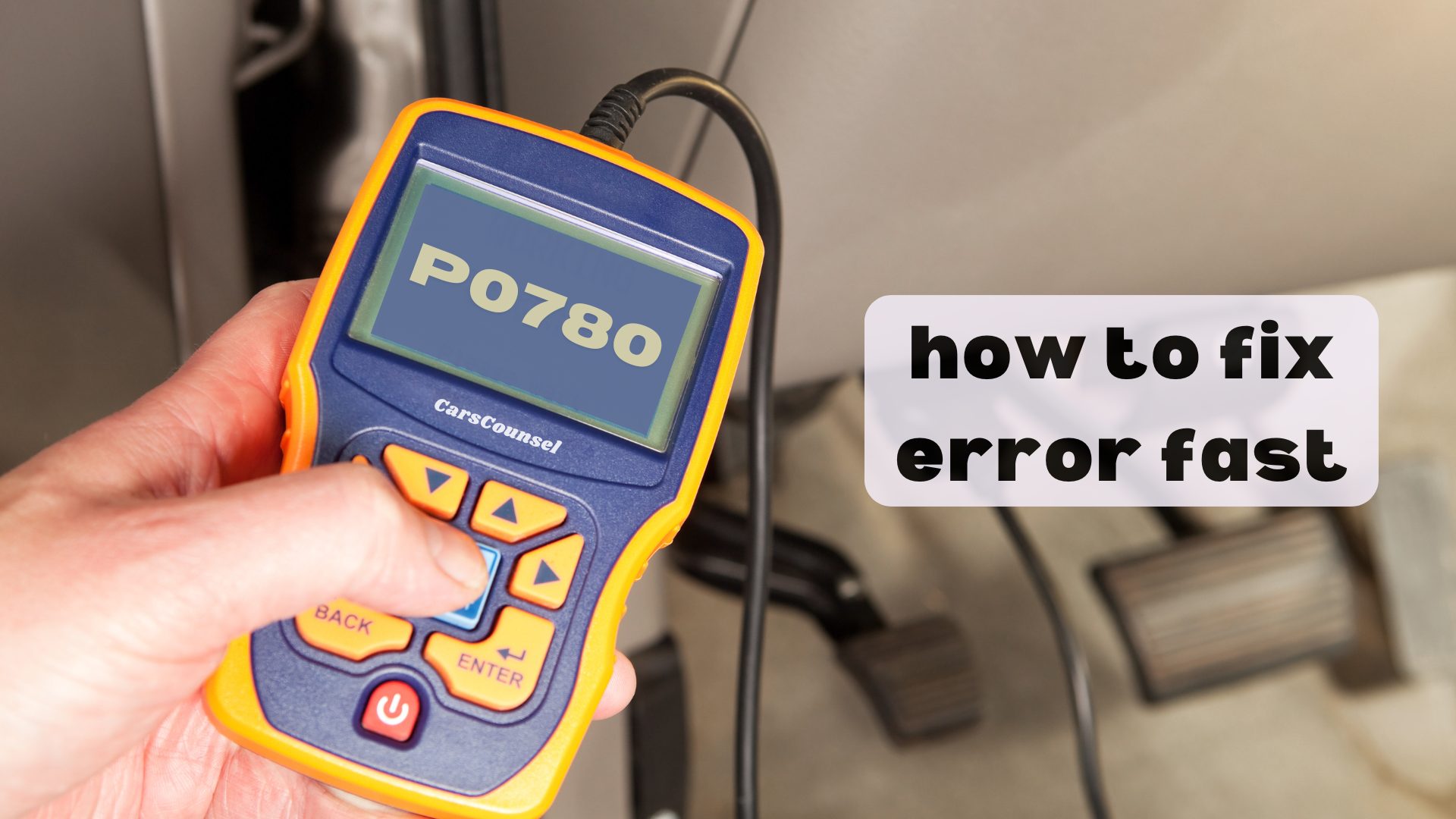When you see the P0780 code, it’s important to fix it quickly to avoid bigger transmission problems later.
First, use an OBD-II scanner to confirm the error code and look for any other related codes.
Check your transmission fluid to make sure it’s at the right level and looks good. If the fluid is dark or burnt, replace it.
Also, inspect the wiring and connections for any damage, as this could be causing the issue.
Next, use a multimeter to test shift solenoid C.
Want to know the next steps to make sure your transmission works smoothly again?

Quick Navigation
Key Takeaways
- Use an OBD-II scanner to confirm the P0780 code and identify any related transmission issues.
- Check the transmission fluid; if it’s dirty or low, replace or refill it to maintain proper hydraulic pressure.
- Look for any damaged or corroded wiring and connectors linked to shift solenoid C and fix or replace them.
- Test shift solenoid C and replace it if it’s faulty to ensure correct gear shifting.
What Is the P0780 Code?
The P0780 code is a general powertrain diagnostic trouble code (DTC) that shows there’s a problem with transmission shift solenoid C. This solenoid is crucial for controlling the hydraulic pressure needed to engage and disengage the transmission clutches.
If it malfunctions, you might notice problems like slipping, rough shifting, or even an inability to shift gears. To avoid these issues, it’s important to maintain your transmission properly. Regularly check and replace the transmission fluid, and pay attention to any warning lights or unusual behavior when shifting gears.
Fixing the P0780 code promptly is essential to prevent further damage to your transmission and ensure smooth driving. Always address these problems right away to keep your transmission in good shape.
Causes of the P0780 Code
A common reason for the P0780 code is a faulty shift solenoid C, which messes up the transmission’s ability to change gears smoothly. To fix this, check the solenoid for wear or electrical problems.
Wiring issues, like damaged or rusty connectors, can also be a problem, so make sure all connections are secure and in good shape.
Another possible cause is a bad Transmission Control Module (TCM), which can mess up communication with the shift solenoid.
Poor transmission maintenance, like having low or dirty transmission fluid, can also cause problems with the hydraulic system. Regularly check and keep your fluid levels clean to avoid contamination.
Symptoms of P0780 Code
When dealing with the P0780 code, you’ll likely notice problems like erratic shifting or slipping gears, which can signal serious transmission issues.
These problems can affect how well your transmission works and may point to issues with the solenoid. Common signs include delayed gear engagement, the transmission not responding in certain gears, and the engine’s RPMs increasing without the car speeding up.
Additionally, the transmission might overheat, causing more damage. It’s important to pay attention to these signs because they can indicate potential failures in the shift solenoid or related parts.
Addressing these symptoms early can prevent further damage and expensive repairs, ensuring your transmission works properly. Regular diagnostic checks and maintenance can help reduce these risks and keep your transmission in good condition.
Using Diagnostic Tools
To effectively diagnose the P0780 code, start by using an OBD-II scanner to get the error code and any related transmission fault codes. Confirm that P0780 is present and take note of any other codes. Next, use other diagnostic tools to check different parts of the system. Here’s a simple guide:
| Tool | Purpose | What to Do |
|---|---|---|
| OBD-II Scanner | Get error codes | Scan and write down all codes |
| Multimeter | Check wiring | Test voltage and continuity |
| Pressure Gauge | Measure pressure | Check system pressure levels |
| TCM Scanner | Check TCM | Look for TCM fault codes |
| Inspection Light | Inspect wiring visually | Look for damage or corrosion |
Use these tools to find the exact cause of the P0780 code so you can fix it properly.
Checking Transmission Fluid
After using diagnostic tools to gather fault codes, the next step is to check the transmission fluid to make sure it’s at the right level and in good shape. This ensures there are no issues that could mess up the hydraulic system.
Start by finding the transmission dipstick. With the engine warmed up and running, pull out the dipstick, wipe it clean, put it back in fully, and then pull it out again to check the fluid level. The fluid should be within the marked range.
To inspect the fluid, look at its color and smell it; it should be a clear red and not smell burnt. If the fluid looks dark or smells burnt, it’s time to change it.
Regular transmission maintenance helps prevent problems like the P0780 code.
Inspecting the TCM
Start the TCM inspection by connecting a scan tool to the car’s OBD-II port to check for any stored fault codes and see how the TCM is doing.
Look for specific codes that might point to a TCM problem. If the TCM seems to be failing, you might need to replace it.
After installing a new TCM, you’ll need to program it so it works correctly with the car’s transmission system. Make sure to follow the manufacturer’s instructions during programming to avoid any problems.
Also, while inspecting, check the wiring and connections to the TCM for any damage or corrosion, as these can mess with the TCM’s performance and cause incorrect fault codes.
Conducting Pressure Tests
Begin by gathering the tools you’ll need, like a pressure gauge and an adapter, to check the hydraulic pressure in the transmission system.
Make sure the vehicle is parked on a flat surface and that the transmission fluid is at the right level.
Attach the pressure gauge to the test port on the transmission.
Start the engine and let it run at idle.
Watch the pressure readings and compare them with what the manufacturer recommends.
If the readings are off, it may mean there’s a problem in the hydraulic system, such as blockages or leaks.
Test the pressure in different gear positions to find out where the issue is happening.
Write down your results; this information is crucial for figuring out the cause of the P0780 code and whether the shift solenoid or another part is to blame.
Visual and Road Tests
After finishing the pressure tests, move on to a careful visual check and then perform road tests to gather more information about the P0780 code.
Start by looking at the wiring and connectors around the transmission for any damage or rust. Make sure the connections are tight and clean.
Once you’ve checked everything over, take the car for a test drive. Pay close attention to how it drives, especially if there are any strange shifts, slipping gears, or delays when you change gears.
Watch the engine RPMs and see how they match up with your speed. This hands-on check will help you find out if the problem is with the shift solenoid or another part of the transmission system.
Repairing Shift Solenoid C
To fix Shift Solenoid C, first disconnect the battery for safety.
Then, check your vehicle’s manual to find where the solenoid is located in the transmission.
Once you find it, take off the transmission pan and filter to get to the solenoid.
Use a multimeter to test if the solenoid has the right resistance.
If it’s bad, replace the old solenoid with a new one, making sure everything is connected well.
Put the transmission filter and pan back on, and refill with the right transmission fluid.
Reconnect the battery and run a diagnostic scan to make sure the P0780 code is cleared.
Preventing P0780 Code
Following the manufacturer’s maintenance schedule for your transmission is key to preventing the P0780 code. Regular maintenance includes changing the fluid on time and keeping the transmission clean.
Check the transmission wiring for wear or corrosion and fix any problems quickly.
Changing your driving habits can help too; avoid aggressive driving and heavy towing, as these can strain the transmission.
Keep an eye out for early signs of transmission trouble, like erratic shifting or strange noises, so you can get it checked right away.
Use diagnostic tools now and then to catch small issues before they become big problems.
Taking good care of your transmission can greatly reduce the risk of seeing the P0780 code.
More OBD-II Codes
Frequently Asked Questions
Can Driving With a P0780 Code Damage My Transmission Further?
Yes, driving with a P0780 code can make your transmission wear out faster. Check your fluid levels, look for wiring problems, and replace any bad parts quickly to avoid bigger transmission damage and expensive repairs.
How Much Does It Typically Cost to Repair a P0780 Code?
Fixing a P0780 code can cost different amounts depending on what needs to be done. Replacing a solenoid might cost between $150 and $400. If it’s the wiring that needs fixing, that could be between $50 and $200. If the Transmission Control Module (TCM) needs to be replaced, it could cost anywhere from $500 to $1,200. It’s a good idea to compare prices and get a solid diagnosis before you decide on the repair.
Is It Safe to Drive My Car With the P0780 Code Active?
Driving with the P0780 code isn’t a good idea. You might notice your transmission slipping or shifting roughly. Use diagnostic tools to check for problems and fix them quickly to avoid more expensive issues later on.
Can Regular Maintenance Prevent the Reoccurrence of the P0780 Code?
Regular maintenance can help keep the P0780 code from coming back. Stick to your car’s maintenance schedule, change the transmission fluid on time, and get regular inspections to make sure your transmission stays in good shape.
Are There Any Aftermarket Solutions for Preventing P0780 Code Issues?
Think of it like upgrading your computer to stop it from crashing. Similarly, you can get aftermarket solutions like better shift solenoids or transmission upgrades for your car. These options make your car more reliable, reduce wear and tear, and lower the chances of seeing the P0780 code again.
Conclusion
To fix the P0780 code, start by confirming the issue with an OBD-II scanner and inspect the transmission thoroughly.
Check the transmission fluid and test shift solenoid C, as these are common causes.
Replace any defective parts and make sure everything is put back together correctly.
Finally, do another diagnostic scan to confirm the fix.
This careful approach not only solves the problem but also helps extend the life of your transmission, reducing future hassles.

